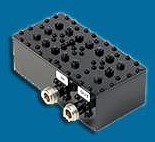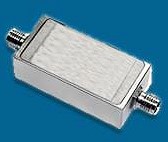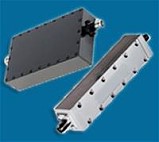|

Sam Benzacar of Anatech Electronics, an RF and microwave filter company, has published
his September 2022 newsletter that features his short op-ed entitled "It's Official:
DSRC is Dead," where he discusses how the 1999 era (Y2K era remember?) "Dedicated
Short-Range Communications (DSRC)," which was allocated 75 MHz of spectrum at 5.9
GHz for "intelligent transportation systems," is no more. "Cellular to Everything
(C-V2X)" is its replacement. Also reported is the introduction of C-Band-proof radar
altimeters, a THz Development grant to NYU's Tandon School of Engineering, and HawkEye
360 developing RF-sensing capabilities for U.S. Army. As always, Sam demonstrates
a keen awareness of the industry for which his company, Anatech Electronics, services.
A Word from Sam Benzacar
It's Official: DSRC is Dead
 By Sam Benzacar By Sam Benzacar
We can now safely say that Dedicated Short-Range Communications (DSRC), for which
the federal government in 1999 designated 75 MHz of spectrum around 5.9 GHz for
"intelligent transportation systems," is dead. And the winner is? You guessed it,
the wireless carriers with its "Cellular to Everything (C-V2X)." This could come
as no surprise, as DSRC was conceived more than two decades ago, when Nokia introduced
the first mobile phone with an internal antenna, Wi-Fi was at IEEE 802.11b, Intel
introduced the "blazingly fast" 400-MHz Celeron processor, and Microsoft released
Windows 95 SE.
Technology has obviously moved on since 1999, but in the government's defense,
if it had not allocated this band when it did it would long ago have been gobbled
up by wireless carriers and Wi-Fi to meet their demands to exceptionally high speeds.
That is, with so little spectrum available at mid-band frequencies for use by 5G,
75 MHz at 5.9 GHz is a prime spot to for reallocation. And DSRC unused, it was inevitable
that the wireless industry would move in for the kill, and it did.
The DSRC allocation is from 5850 to 5925 MHz and sits squarely between the U-NII-3
band at 5725 to 5850 MHz used by Wi-Fi and the U-NII-5 band between 5925 to 6425
MHz. The FCC in 2013 proposed Wi-Fi sharing in the 5.9 GHz band and designated it
as the U-NII-4 band. Automakers, assuming that DSRC would be the de facto solution
for meeting the needs of vehicle autonomy when the time came to deploy it, spent
a reported $800 million on DSRC, conducted many trials based on its basic architecture,
and were adamant that their work should not go to waste.
And until this day, some in the auto industry stand behind DSRC but even before
5G arrived it became evident that cellular had the potential to make DSRC obsolete.
While DSRC requires dedicated roadside infrastructure, cellular already has it nearly
everywhere, and it can be used for every purpose that will be required for full
vehicle autonomy. Speed is no problem either because even 4G LTE has the necessary
data rates that is far faster than what would be achievable with DSRC. Sensors from
radar to lidar, cameras, and mapping have made dramatic advances, all of which would
work with existing cellular networks and others in development.
In the hopes of placating everyone, the FCC took the "bold" step of mandating
the phase-out of DSRC, and Congress chimed by offering incentives for the auto industry
to stop fighting the inevitable and join the C-V2X party. The FCC voted to shift
30 MHz of the 75 MHz reserved for DSRC to C-V2X on an exclusive basis and allocated
45 MHz for Wi-Fi use. While 30 MHz isn't much spectrum, the modulation techniques
used by the wireless industry are very efficient, so the full band wasn't necessary.
So, has this debacle finally been concluded? For practical purposes, DSRC is
dead because the momentum behind C-V2X is unstoppable and there is no longer any
time left for dithering. Except for a few outliers, automakers have already shifted
gears toward C-V2x and suppliers such as Qualcomm and others are making chipsets
and other hardware available.
 5G-Immune Radar Altimeters Appear 5G-Immune Radar Altimeters Appear
Avionics manufacturer FreeFlight Systems' Terrain series of radar altimeters
has received FAA certification to meet performance standards for airborne low-range
radar altimeters free from interference by 5G cellular telephone networks. They
are a response to the recent frenzy over potential interference with existing radar
when C-band base stations are located near airports. The issue pitted wireless carriers
against the airline industry and even wound up in Congress. The problem is essentially
that many radar altimeters and service of insufficient bandpass filtering to reject
signals nearby, although the controversy focused on whether this was the case considering
there is considerable guard band in place to prevent interference.
 NYU Wireless Gets $3 Million for Terahertz Development NYU Wireless Gets $3 Million for Terahertz Development
The NYU Wireless research center at the NYU Tandon School of Engineering has
received $3 million from the National Science Foundation to lay the groundwork for
terahertz mobile wireless communication and to launch a new terahertz measurement
facility. The award will help NYU and its collaborators, the University of Colorado
at Boulder, University of Nebraska–Lincoln, and Florida International University,
pioneer basic measurements of devices, circuits, materials, and radio propagation
channels at the highest reaches of the radio spectrum. Terahertz radio spectrum
presents possibilities and challenges for mobile communications from see-in-the-dark
sensors and revolutionary imaging and communications technologies to Tricorder-like
medical devices.
 HawkEye 360 to Develop RF-sensing Capabilities
for U.S. Army HawkEye 360 to Develop RF-sensing Capabilities
for U.S. Army
HawkEye 360 has received a Cooperative Research and Development Agreement (CRADA)
with the U.S. Army Space and Missile Defense Command (SMDC) to develop Satellite-based
RF-sensing capabilities to provide tactical support for warfighters. The program
will support the Army's initiative to develop more effective systems that strengthen
how it mobilizes, protects, and sustains expeditionary forces leveraging tactically
relevant commercial RF information.
Anatech Electronics Introduces a New Line of Suspended Stripline and
Waveguide Type RF Filters
Check out Our Filter Products



Cavity Band Pass Filters
LC Band Pass Filters Cavity Bandstop/Notch Filter
About Anatech Electronics
Anatech Electronics, Inc. (AEI) specializes in the design and manufacture of
standard and custom RF and microwave filters and other passive components and subsystems
employed in commercial, industrial, and aerospace and applications. Products are
available from an operating frequency range of 10 kHz to 30 GHz and include cavity,
ceramic, crystal, LC, and surface acoustic wave (SAW), as well as power combiners/dividers,
duplexers and diplexers, directional couplers, terminations, attenuators, circulators,
EMI filters, and lightning arrestors. The company's custom products and capabilities
are available at www.anatechelectronics.com.
Contact:
Anatech Electronics, Inc.
70 Outwater Lane
Garfield, NJ 07026
(973)
772-4242
sales@anatechelectronics.com
Posted September 26, 2022
|





























 By Sam Benzacar
By Sam Benzacar 5G-Immune Radar Altimeters Appear
5G-Immune Radar Altimeters Appear NYU Wireless Gets $3 Million for Terahertz Development
NYU Wireless Gets $3 Million for Terahertz Development HawkEye 360 to Develop RF-sensing Capabilities
for U.S. Army
HawkEye 360 to Develop RF-sensing Capabilities
for U.S. Army




